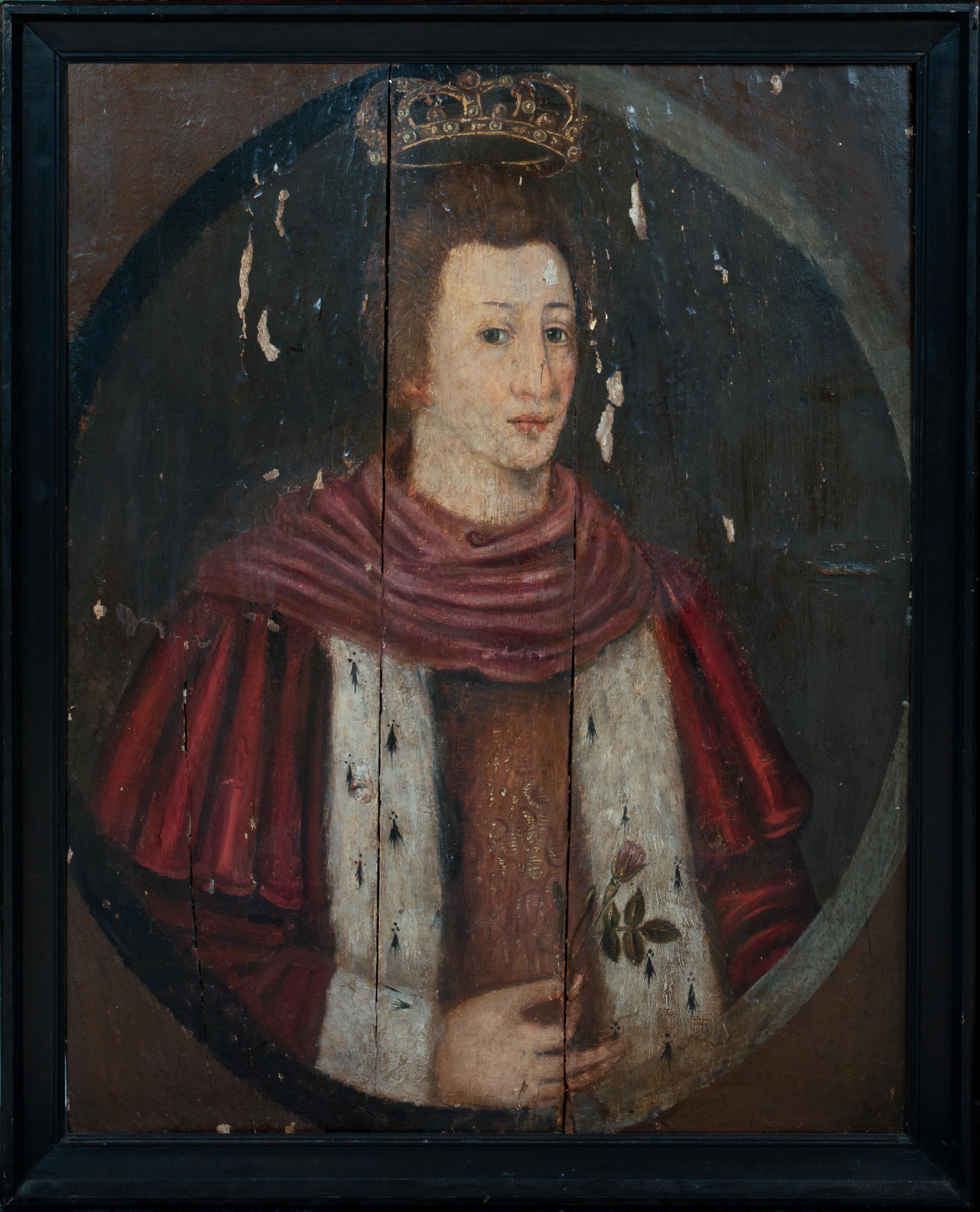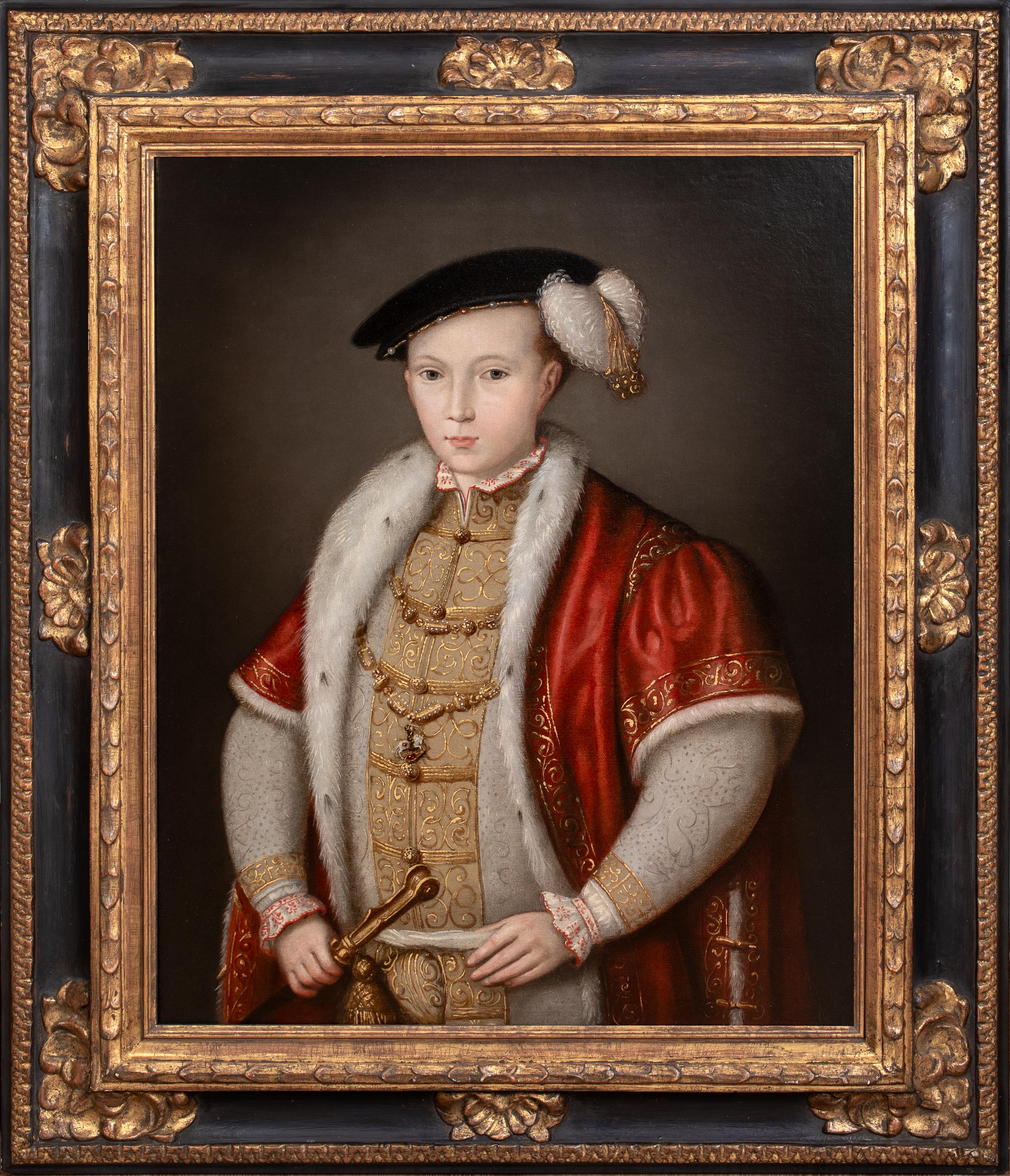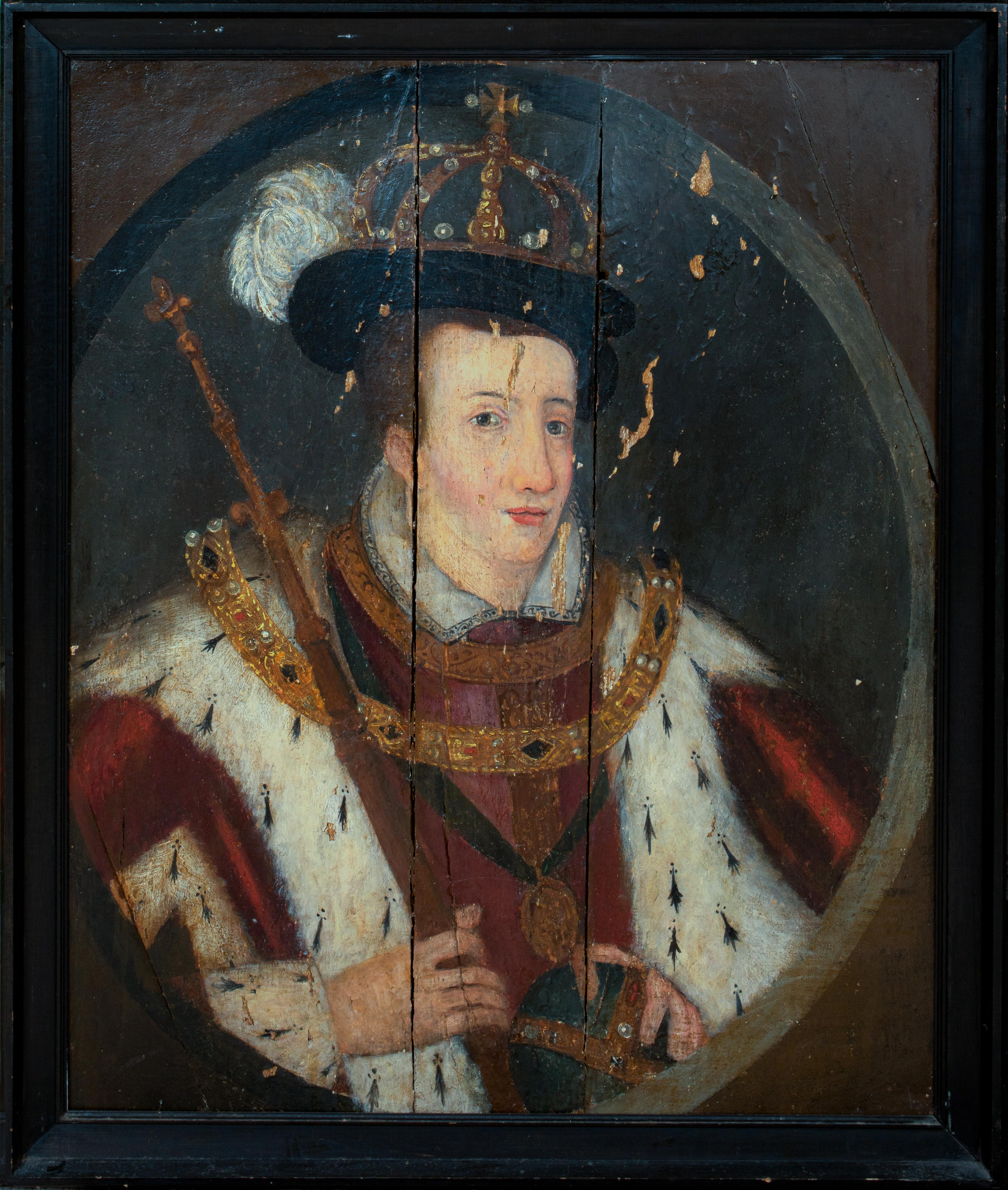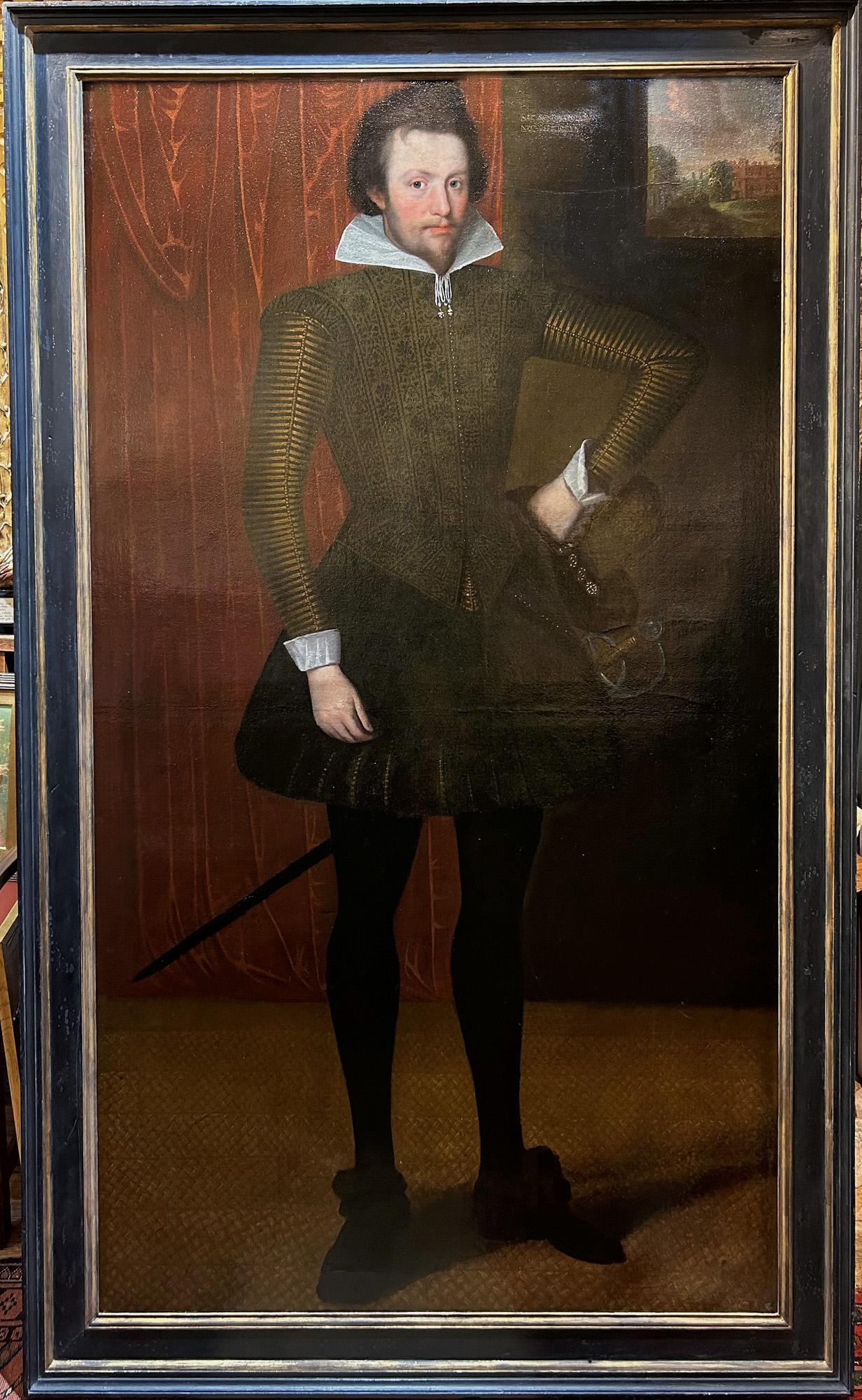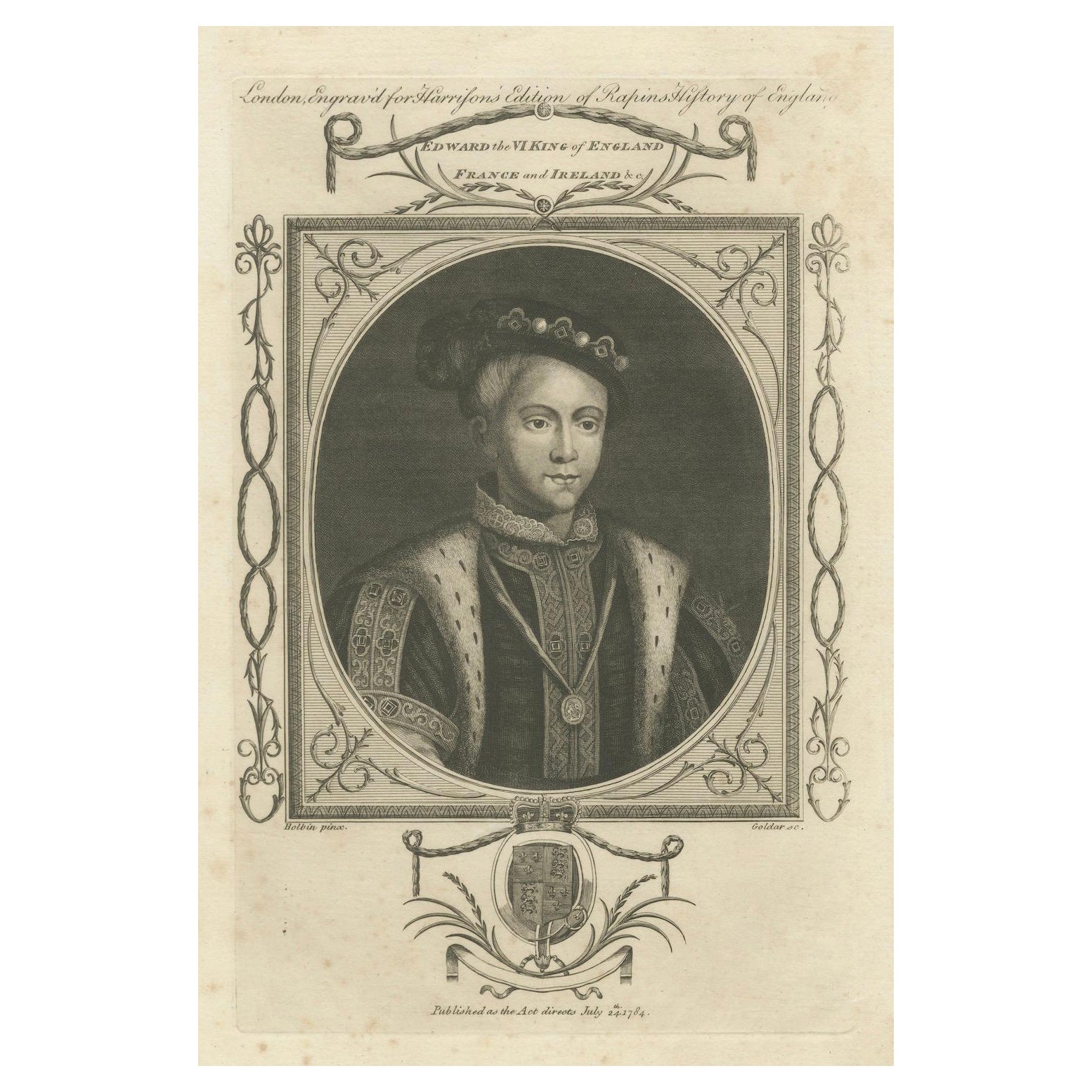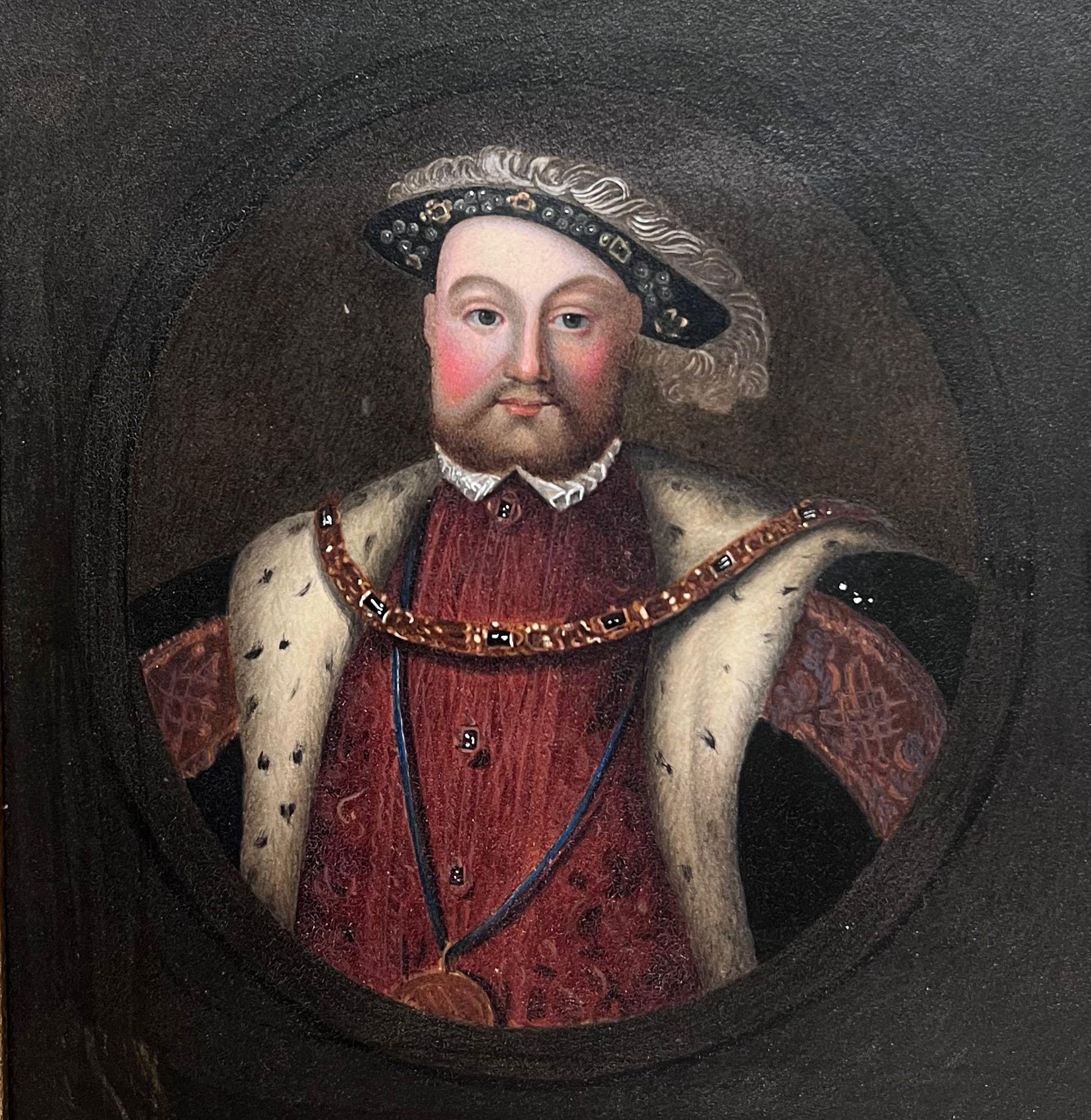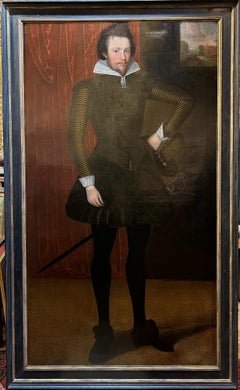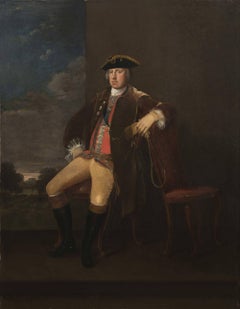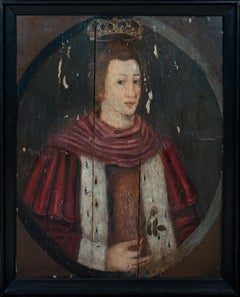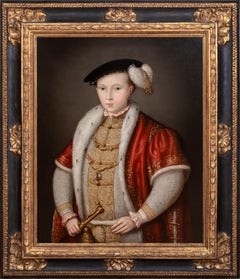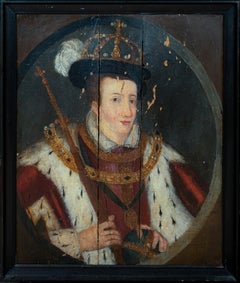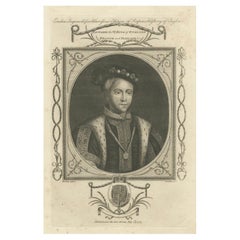Items Similar to Portrait of King Edward VI, Oil on panel with Gold Leaf, 18th Century English
Want more images or videos?
Request additional images or videos from the seller
1 of 7
English school 18th centuryPortrait of King Edward VI, Oil on panel with Gold Leaf, 18th Century English
$23,454.21
£17,000
€20,054.54
CA$32,260.91
A$35,860
CHF 18,797.05
MX$437,937.42
NOK 234,670.27
SEK 220,780.95
DKK 149,681.28
About the Item
Oil on oak panel
Image size: 25 1/2 x 19 inches (37.5 x 27 inches)
18th Century Auricular gilt frame
Provenance
New York private collection
This portrait of the King Edward VI depicts the boy-king standing in a black and gold embroidered doublet, wearing a jewelled cap. King Edward holds a staff with a globus cruciger set on the table beside him. No expense has been spared in the making of this piece, with gold leaf being applied in many areas to give the effect of the costume's gold embroidery, chain of office and other metal accessories.
As the precious male heir to the Tudor dynasty, Edward's childhood was very well documented through portraiture with the earliest portrait of the young prince being developed by Holbein when he was only two years old. The heir to the English throne, ‘His Majesty’s most noble jewel’, was brought up with every precaution to ensure his good health. Recent research reveals him as a normally strong and healthy boy, fond of athletic exercises such as hunting and hawking.
Edward was little more than nine years old when he succeeded to the throne on the death of his father Henry VIII in 1547. Edward's reign was fated to be short as he was only fifteen when he died. After Edward’s accession to the throne, he appears to have sat only once for his portrait in around 1550, painted by William Scrots. Scrots had recently inherited the mantle of ‘King’s Painter’ from Holbein in 1545, and at the Prince’s succession, he oversaw in his studio the production of numerous portraits of Edward. This sitting was the likely source for all the subsequent variants, in all shapes and sizes, produced of Edward as King, by the Scrots studio, both during the monarch’s brief reign and after Elizabeth I’s accession and the subsequent re-affirmation of the Protestant faith.
In April 1552, he suffered from measles and smallpox, recovering by the end of May, and thereafter he was very much under the influence of the Duke of Northumberland. However, early in 1553, Edward became ill (possibly with consumption), from which he never recovered. At this time, the Duke of Northumberland convinced Edward to ‘devise’ the succession to Lady Jane Grey, Northumberland’s daughter-in-law. Edward VI died on 6 July 1553 and was buried in Westminster Abbey.
- Creator:English school 18th century
- Dimensions:Height: 25.5 in (64.77 cm)Width: 18 in (45.72 cm)
- More Editions & Sizes:1 of 1Price: $23,454
- Medium:
- Movement & Style:
- Period:
- Condition:
- Gallery Location:London, GB
- Reference Number:1stDibs: LU52414262012
About the Seller
5.0
Vetted Professional Seller
Every seller passes strict standards for authenticity and reliability
Established in 2007
1stDibs seller since 2014
82 sales on 1stDibs
Typical response time: 3 hours
- ShippingRetrieving quote...Shipping from: London, United Kingdom
- Return Policy
Authenticity Guarantee
In the unlikely event there’s an issue with an item’s authenticity, contact us within 1 year for a full refund. DetailsMoney-Back Guarantee
If your item is not as described, is damaged in transit, or does not arrive, contact us within 7 days for a full refund. Details24-Hour Cancellation
You have a 24-hour grace period in which to reconsider your purchase, with no questions asked.Vetted Professional Sellers
Our world-class sellers must adhere to strict standards for service and quality, maintaining the integrity of our listings.Price-Match Guarantee
If you find that a seller listed the same item for a lower price elsewhere, we’ll match it.Trusted Global Delivery
Our best-in-class carrier network provides specialized shipping options worldwide, including custom delivery.More From This Seller
View AllSir Rowland Cotton (1581 – 1634), Tudor Oil on Canvas, Life Size Painting
Located in London, GB
Oil on original canvas
Image size: 78 1/4 x 44 inches (199 x 112 cm)
Contemporary style frame
Provenance
Sir Rowland Cotton, 1608
Family Descent
Private Collection
Sir Rowland Cot...
Category
17th Century English School Figurative Paintings
Materials
Canvas, Oil
Portrait of a King's Messenger, 18th Century English Artist, Original Frame
By Charles Philips
Located in London, GB
Charles Philips
1703 - 1747
Portrait of a King's Messenger
Oil on canvas
Image size: 35 ¾ x 28 inches
Original gilt frame
King's Messenger
The job of a King's Messenger was that of a diplomatic courier, hand-carrying important and secret documents around the world. Some say that the history of the sovereigns' messengers goes back to 1199, but the first known messenger was John Norman, who in 1485 earned 4d (1½ pence) per day for carrying the state papers of Richard III.
The silver greyhound on the messenger's badge dates back to Charles II. In 1660, during his exile at Breda, Netherlands, Charles II issued a declaration of amnesty to all those who had opposed him and his father. He used messengers to make his intentions known. In answer to the messenger's question "How will they know me?", Charles reached forward to a silver bowl on the table in front of him. This bowl, with four decorative greyhounds standing proud above the rim, was well known to all courtiers. Charles broke off a greyhound and gave it to the messenger as a guarantee that the message came from him. From that date, the King's Messenger always wore a silver greyhound around his neck.
Later, dating from George II or III, a badge with the Royal Arms in enamel, with the greyhound suspended beneath, was worn. A George III example of the King's Messenger Badge, pre 1800, sold for over £30,000 pounds some years ago.
The silver greyhounds were minted for each new reign, except the brief one of King Edward VIII. The sovereign's messengers were originally controlled by the Lord Chamberlain, being Messengers of the Great Chamber. When the Foreign Office was created in 1782, the messengers remained common to the three Secretaries of State.
Charles Philips was an English artist known for painting a number of portraits and conversation pieces for noble and Royal patrons in the mid-eighteenth century.
Philips was baptised in the combined parish of St Mildred, Poultry with St Mary...
Category
18th Century Portrait Paintings
Materials
Canvas, Oil
Portrait of a Young Man - 17th Century Portrait in Oil
By Pieter Harmensz Verelst
Located in London, GB
Circle of Pieter Harmensz Verelst
1618 - 1678
Portrait of a Young Man
Oil on oak panel
Image size: 7 ½ x 5 ¾ inches
Dutch ripple frame
Category
18th Century and Earlier Old Masters Portrait Paintings
Materials
Oil, Panel
Self-Portrait - Royal Academy Founding Member, 18th Century
By Francis Hayman
Located in London, GB
Francis Hayman RA
1708–1776
Self-Portrait
Oil on oak panel
Image size: 8 x 6¼ inches
Contemporary gilt frame
This newly discovered work is the earliest known self portrait by Francis Hayman, dated to the mid to late 1720’s. The small scale of the portrait gives it a strong sense of intimacy. Whereas clients would often dress themselves in their best clothes for a sitting, Hayman has portrayed himself in informal attire, with his shirt unbuttoned and a wig cap.
Born in 1708 to a respectable Devonshire family, his training began at the tender age of ten under the tutelage of the historical painter Robert Brown, who was probably an uncle. By the 1730’s he is known to have been engaged in painting scenery for the popular theatres on Goodman’s Fields and Drury Lane. He established a studio on St Martin’s Lane, and demonstrated his versatility as one of the most
important painters of his time in portraits, illustration and history painting.
Indeed, he was one of the first English painters deemed to have the skill and proficiency to rival that of the foreign masters, such as Holbein and Kneller, who were brought in by the court to make up for the perceived shortcomings of the native artists. Led by William Hogarth, Hayman and other artists began to create a new movement in the English art world. Thomas Gainsborough was one of his pupils, whom he is said to have introduced to the more lascivious and debauched underbelly of London life.
After mostly making his living as an illustrator, in the 1740’s Hayman was commissioned by the proprietor of the Vauxhall Pleasure Gardens, Jonathan Tyers, to produce a series of four large celebratory canvases depicting British victories from the Seven Years War. His association with Tyers continued, and over the next ten years he produced a number of large decorative paintings...
Category
18th Century Old Masters Portrait Paintings
Materials
Oak, Oil Pastel
Portrait of a Young Boy Carrying a Fruit Basket, 18th Century Oil on Canvas
By Thomas Beach
Located in London, GB
Oil on canvas
Image size: 30 x 25 inches (76 x 63.5 cm)
Contemporary hand-carved frame
This is a charming 18th century portrait of a young boy, sporting a golden child's two-piece w...
Category
18th Century English School Portrait Paintings
Materials
Canvas, Oil
Portrait of a Girl, 17th Century English School Old Masters Oil
By Gilbert Jackson
Located in London, GB
Gilbert Jackson
English Active: 1620 - 1650
Portrait of a Girl
Oil on panel, signed upper left and Inscribed upper right
Image size: 24 ½ x 20 inches
Contemporary style hand made...
Category
17th Century Old Masters Portrait Paintings
Materials
Oil
You May Also Like
Portrait Of King Edward VI (1537-1553) as Prince Of Wales, 16th Century
Located in Blackwater, GB
Portrait Of King Edward VI (1537-1553) as Prince Of Wales, 16th Century
English School - Oil on panel - circa 1547
Large 16th Century portrait of Edward VI as Prince Of Wales, oil on panel. Early and important portrait...
Category
16th Century Portrait Paintings
Materials
Oil, Wood Panel
$10,926 Sale Price
20% Off
Court Portrait Of King Edward VI (1537-1553) King Of England
Located in Blackwater, GB
Portrait Of King Edward VI (1537-1553) King Of England
after William SCROTS (1510-1553)
Large circa 17th/18th Century portrait of Edward VI, King Of England, oil on canvas. Excellent quality and condition half length portrait of the only surviving son of King Henry VIII and Jane Seymour wearing Prince Of Wale Feathers and the crown upon a pendant. Exceptional quality distinctly similar to the works of court painter William Scrots. Presented in a gilt & ebony frame.
Measurements: 40" x 34" framed approx
Provenance: The estate of Richard Philip...
Category
17th Century Portrait Paintings
Materials
Canvas, Oil
Coronation Portrait Of King Edward VI (1537-1553) as King Of England & Ireland
Located in Blackwater, GB
Coronation Portrait Of King Edward VI (1537-1553) as King Of England & Ireland, 16th Century
English School - Oil on panel - circa 1547
Large 16th Century Coronation portrait of Edward VI as King Of England & Ireland, oil on panel. Early and important portrait...
Category
16th Century Portrait Paintings
Materials
Oil, Wood Panel
$10,926 Sale Price
20% Off
1784 Engraved Portrait of Edward VI - Young English Monarch
Located in Langweer, NL
An original antique engraved portrait from Harrington's edition of "Rapin's History of England."
The text identifies the subject as Edward the VI, King of England, France, and Ireland. The engraving is again by Goldar, indicating John Goldar's work, and it was published as the act directs on July 22nd, 1784.
Edward VI was the son of Henry VIII and his third wife, Jane Seymour. Born on October 12...
Category
Antique 1780s Prints
Materials
Paper
Portrait King Henry 8th VIII Antique English Painting Famous Monarch
Located in Cirencester, Gloucestershire
King Henry VIII
English artist, circa 1840's
oil on paper laid on board, framed
framed: 10.5 x 10inches
board: 8 x 7.5 inches
inscribed verso
provenance: private collection, UK
cond...
Category
Early 19th Century English School Portrait Paintings
Materials
Oil
19th century English Portrait of a Young boy in a Cavalier costume
Located in Woodbury, CT
This elegant English 19th-century portrait of a young boy dressed in a Cavalier costume, painted circa 1860, is a striking example of Victorian portraiture that seamlessly combines h...
Category
1860s Old Masters Portrait Paintings
Materials
Canvas, Oil
More Ways To Browse
18th Century Jewels
18th Century Gilt Frame
18th Century English Painting
Antique Metal Panel
Antique 18th Century English Frames
18th Century English Table
18th Century English Portrait
King Edward
English Hunting
18th Century Costume
Dior Two Piece Set
Antique Gold Embroidery
18th Century Embroidered
King Throne
Tudor Gold
X Frame Throne
18th Century Hunting Paintings
Throne Table
